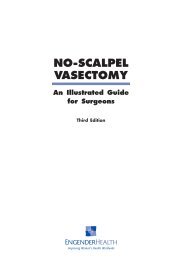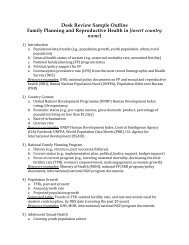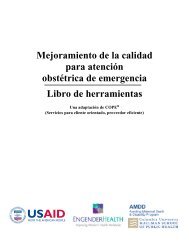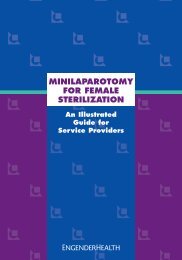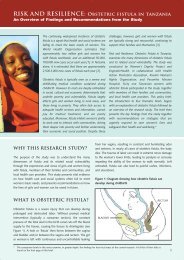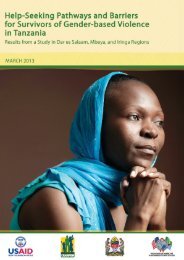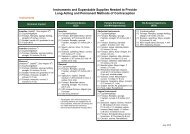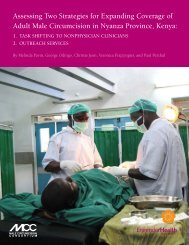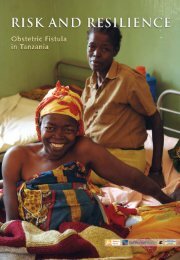COPE® FOR MALE CIRCUMCISION SERVICES - EngenderHealth
COPE® FOR MALE CIRCUMCISION SERVICES - EngenderHealth
COPE® FOR MALE CIRCUMCISION SERVICES - EngenderHealth
Create successful ePaper yourself
Turn your PDF publications into a flip-book with our unique Google optimized e-Paper software.
References<br />
COPE for Male Circumcision Services<br />
Agarwal, S. S., et al. 1993. Role of male behavior in cervical carcinogenesis among women<br />
with one lifetime sexual partner. Cancer 72(5):1666–1669.<br />
American Academy of Pediatrics. 1989. Report of the task force on circumcision. Pediatrics<br />
84(2):388–391.<br />
Auvert, B., Buvé, A., Ferry, B., et al. 2001. Ecological and individual level analysis of risk<br />
factors for HIV infection in four urban populations in sub-Saharan Africa with different levels<br />
of HIV infection. AIDS 15(Suppl. 4):S15–S30.<br />
Auvert, B., Taljaard, D., Lagarde, E., et al. 2005. Randomized, controlled intervention trial of<br />
male circumcision for reduction of HIV infection risk: the ANRS 1265 Trial. PLoS Med<br />
2(11):e298.<br />
Baeten, J. M., Donnell, D., Kapiga, S. H,, et al. 2010. Male circumcision and risk of male-tofemale<br />
HIV-1 transmission: A multinational prospective study in African HIV-1-<br />
serodiscordant couples. AIDS 24(5):737–744.<br />
Bailey, R. C., Moses, S., Parker, C. B., et al. 2007. Male circumcision for HIV prevention in<br />
young men in Kisumu, Kenya: A randomised controlled trial. Lancet 369(9562):643–656.<br />
Cameron, D., Simonsen, J. N., d’Costa, L. J., et al. 1989. Female to male transmission of<br />
human immunodeficiency virus type 1: Risk factors for seroconversion in men. Lancet<br />
19(8660):403–407.<br />
Centers for Disease Control and Prevention (CDC). 2008. HIV/AIDS science facts: Male<br />
circumcision and risk for HIV transmission and other health conditions: Implications for the<br />
United States. Atlanta.<br />
Cook L. S., Koutsky, L. A., and Holmes, K. K. 1994. Circumcision and sexually transmitted<br />
diseases. American Journal of Public Health 84(2):197–201.<br />
Dodge, O. G., and Kaviti, J. N. 1965. Male circumcision among the peoples of East Africa and<br />
the incidence of genital cancer. East African Medical Journal 42:98–105.<br />
<strong>EngenderHealth</strong>. 2003. COPE ® handbook: A process for improving quality in health services.<br />
New York.<br />
Gray, R. H., Kigozi, G., Serwadda, D., et al. 2007. Male circumcision for HIV prevention in<br />
men in Rakai, Uganda: A randomised trial. Lancet 369(9562):657–666.<br />
Gray, R. H., Kigozi, G., Serwadda, D., et al. 2009. The effects of male circumcision on female<br />
partners’ genital tract symptoms and vaginal infections in a randomized trial in Rakai,<br />
Uganda. American Journal of Obstetrics and Gynecology 200(1): 42.e1–7.<br />
Huezo, C., and Diaz, S. 1993. Quality of care in family planning: Clients’ rights and providers’<br />
needs. Advances in Contraception 9(2):129–139.<br />
<strong>EngenderHealth</strong> 85



